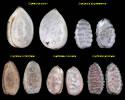Euphorbia serpillifolia (Thyme-leaved Spurge)
| Also known as: | Thyme-leaf Sandmat |
|---|---|
| Genus: | Euphorbia |
| Family: | Euphorbiaceae (Spurge) |
| Life cycle: | annual |
| Origin: | native |
| Habitat: | part shade, sun; dry, sandy or gravelly soil; lawns, waste areas, roadsides, railroads, woods, forests, fields |
| Bloom season: | July - October |
| Plant height: | .25 to 4 inches |
| Wetland Indicator Status: | none |
| MN county distribution (click map to enlarge): |  |
| National distribution (click map to enlarge): |  |
Pick an image for a larger view. See the glossary for icon descriptions.
Detailed Information
Flower: 

![[photo of flowers]](/udata/r9ndp23q/pd/euphorbia-serpyllifolia-071614-14-t.jpg) Flowers are tiny and nearly indistinct, 1 to a few clustered in leaf axils along the branches. A small cup, 1/8 inch across, holds the male and female flowers in the center.
Flowers are tiny and nearly indistinct, 1 to a few clustered in leaf axils along the branches. A small cup, 1/8 inch across, holds the male and female flowers in the center.
![[close-up of flowers]](/udata/r9ndp23q/pd/euphorbia-serpyllifolia-091117-1-t.jpg) The rim of the cup has 4 white to pink, barely discernible petal-like appendages with a thickened gland at the base that is greenish-yellow to red. The male flower anthers are white to yellow and nearly indistinct. The single female flower in the center is green, the small pistils atop a round, three part ovary on a short stalk that extends out from the flower center. The structure of this flower is called a cyathium and common to all the Euphorbias.
The rim of the cup has 4 white to pink, barely discernible petal-like appendages with a thickened gland at the base that is greenish-yellow to red. The male flower anthers are white to yellow and nearly indistinct. The single female flower in the center is green, the small pistils atop a round, three part ovary on a short stalk that extends out from the flower center. The structure of this flower is called a cyathium and common to all the Euphorbias.
Leaves and stems: 

![[photo of leaves]](/udata/r9ndp23q/pd/euphorbia-serpyllifolia-071614-31-t.jpg) Leaves are opposite, oval to oblong but usually widest at or above the middle, ¼ to ½ inch long, surfaces hairless and green with a faint to prominent red splotch mid-leaf, shallowly toothed on the tip half, rounded at the tip, strongly asymmetrical at the base, on a short stalk, with a bit of fringe at the leaf nodes. Stems are hairless, branching heavily from the base and upper branches, forming dense spreading mats up to 14 inches across. Leaves and stems exude milky sap when broken.
Leaves are opposite, oval to oblong but usually widest at or above the middle, ¼ to ½ inch long, surfaces hairless and green with a faint to prominent red splotch mid-leaf, shallowly toothed on the tip half, rounded at the tip, strongly asymmetrical at the base, on a short stalk, with a bit of fringe at the leaf nodes. Stems are hairless, branching heavily from the base and upper branches, forming dense spreading mats up to 14 inches across. Leaves and stems exude milky sap when broken.
Fruit: 
![[photo of fruit]](/udata/r9ndp23q/pd/euphorbia-serpylliifolia-081616-5-t.jpg) Fruit is a 3-lobed stalked capsule, up to 2 mm long and wide, that develops rapidly from the center of the cyathium, initially hanging down, becoming erect at maturity.
Fruit is a 3-lobed stalked capsule, up to 2 mm long and wide, that develops rapidly from the center of the cyathium, initially hanging down, becoming erect at maturity.
![[photo of seed]](/udata/r9ndp23q/pd/euphorbia-serpyllifolia-091117-9-t.jpg) Seeds are less than 1.5 mm long, pinkish to light brown to gray, 4-sided in cross-section, narrowly oval to egg-shaped in outline, covered in tiny pits across the surface, and without conspicuous transverse ridges.
Seeds are less than 1.5 mm long, pinkish to light brown to gray, 4-sided in cross-section, narrowly oval to egg-shaped in outline, covered in tiny pits across the surface, and without conspicuous transverse ridges.
Notes:
Thyme-leaved Spurge (Latin epithet commonly [mis]spelled serpyllifolia), is a fairly common and widespread mat-forming spurge species, widely adapted to harsh urban environments, being weedy in compacted lawn areas, cracks of hard pavement, and gravelly roadsides. Characteristics that identify Thyme-leaved Spurge from other mat-forming Spurges are the hairless stems; leaves that are finely toothed at least on the tip end, often widest above the middle (obovate), usually with a red splotch in the center; and angular seeds that lack conspicuous transverse ridges. Minnesota has two other hairless, mat-forming Spurges: Geyer's Spurge (Euphorbia geyeri), which has toothless leaves, and Ridge-seed Spurge (Euphorbia glyptosperma), which has leaves usually oblong or widest below the middle and are not red-spotted, and seeds with conspicuous transverse ridges. The other two mat-forming Spurges in Minnesota, Spotted Spurge (Euphorbia maculata) and Prostrate Spurge (Euphorbia prostrata) both have hairy stems, leaves and capsules.
There are possibly two (or more?) subspecies of E. serpillifolia, though these are not universally recognized: subsp. hirtula, found in Mexico and California, has hairy leaves and stems where subsp. serpillifolia is hairless. These subspecies are not currently recognized in Minnesota.
Native Plant Nurseries, Restoration and Landscaping Services ↓
More photos
 Thyme-leaved Spurge plant
Thyme-leaved Spurge plant Thyme-leaved Spurge plant
Thyme-leaved Spurge plant Thyme-leaved Spurge plant
Thyme-leaved Spurge plant Thyme-leaved Spurge plant
Thyme-leaved Spurge plant Thyme-leaved Spurge in a pavement crack
Thyme-leaved Spurge in a pavement crack Thyme-leaved Spurge on a gravelly roadside
Thyme-leaved Spurge on a gravelly roadside leaf comparison of Euphorbia geyeri, E. glyptosperma, E. serpillifolia
leaf comparison of Euphorbia geyeri, E. glyptosperma, E. serpillifolia seed comparison of mat-forming Euphorbia species
seed comparison of mat-forming Euphorbia species
Photos by K. Chayka taken in Lake County. Photos courtesy Peter M. Dziuk taken in Clearwater, Cook, Lake and Traverse counties, and in North Dakota.
Comments
Have you seen this plant in Minnesota, or have any other comments about it?






